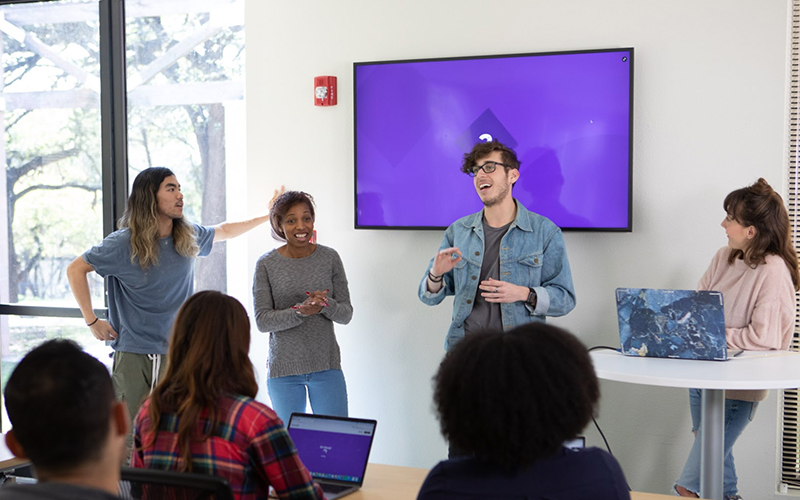Earlier this year, we reached out to Gen Z knowledge workers across the U.S. to learn more about their work life experiences, challenges, and needs – to help businesses to develop learning and engagement strategies that both support their young employees and help these companies thrive in the future of work. One of the most interesting findings in the survey, the Kahoot! ZetaPulse Gen Z Workforce Study, was Gen Z’s SOS plea for soft skills training, including communication, leadership, and negotiation skills.

When we asked Gen Z’ers what their employer should focus on to help them close skill gaps, soft skills training came in at the top of their priorities list (42%). At a time of often dizzying leaps in technological advancement, young people are asking for support with navigating humans.
Why is there such a strong call for soft skills training among Gen Z? It’s unsurprising with the reveal of another key finding, that 90% of Gen Z knowledge workers report experiencing social anxiety or discomfort at work, 35% experiencing it on a near-daily basis.
Why do soft skills matter in the workplace?
As the landscape of work and business continues to evolve, it has become very clear that soft skills, such as communication, are not simply nice-to-haves. They’re essential for teams to work together effectively. This is especially true with the increase in hybrid and remote work, which can require employees to take a more proactive approach to communication – without the spontaneous interactions of the office – as well as to be flexible in how they communicate with their team.
When young employees don’t feel confident in their soft skills and are experiencing social discomfort at work, it can hold them back from sharing their ideas, insights, and knowledge, and collaborating with their team. Not only can this hold them back professionally; it can impact the entire team’s performance.
The good news: research shows that soft skills training can be a powerful way to reduce social discomfort. As people learn valuable communication and other social skills (especially those relevant to the professional sphere), they become more confident and comfortable in social situations at work.
So how should businesses focus their soft skills training? Consider these three key areas:
1) Overcoming presentation nerves
When we asked Gen Z’ers what made them feel anxious at work, the ever-daunting (but rare) scenario of asking for a raise topped the list at 48%. Concerningly however, this was followed (44%) by the very common experience of being asked to give a presentation. Presentations are excellent opportunities for peer learning, where employees can share their knowledge. However, as it’s seen as public speaking, it can quickly become intimidating.
One way to help employees dissolve those nerves is to show employees how to turn their presentations into interactive experiences. Instead of presenting a simple slideshow that keeps all eyes on the speaker, guide employees to get the audience involved through quick polls, idea generation, and other questions. Gamifying the experience can amplify engagement even more, transforming it from a presentation to a friendly knowledge championship. As the presenter sees participants engaged and even having fun, they build confidence in their skills as a communicator, facilitator, and leader. As a bonus, the audience is more likely to remember what they’ve learned.
2) Speaking up during meetings
Another work situation many Gen Z’ers (38%) cited as anxiety-inducing was being asked unexpectedly to share their opinion in a meeting. This makes sense, as many people feel they need to, in a way, “perform” to fit their company’s professional culture and perform at their best. However, while fundamental professionalism is important, creating a feeling of safety and openness in group activities like meetings can make them much more collaborative, and ultimately productive. The majority of Gen Z knowledge workers agree, with 53% saying they would feel more encouraged to speak up and share their input if their team created a safe, non-judgmental environment.
Companies can create a more positive environment in meetings in many ways, such as brainstorming where there are no wrong answers, and regularly opening the floor to questions, input, and discussion. Meeting hosts can also take advantage of digital tools to give participants the option to share their thoughts and ideas anonymously.
Get started with brainstorming with Kahoot! today!
3) Breaking the ice
When it comes to supporting your Gen Z employees in navigating social situations at work, breaking the ice and helping them form connections with other team members is a solutions multiplier. People who feel connected to their coworkers are more likely to feel comfortable across work activities, from meetings to presentations to collaboration and beyond.
A great place to start here is friendly competition. Game-based experiences – whether integrated into your training or simply as an icebreaker – can break down barriers and help co-workers connect on a more human level. Especially when made more accessible with technology, it’s also a great way to get everyone participating, without relying on people proactively speaking up.
Discover 10 icebreaker activities on Kahoot!
At the end of the day, more connected employees are more confident employees. When we give people the tools to connect more effectively – both the skills and a positive environment to practice in – it can be truly game-changing for employees, their team, and the company as a whole.
*This article is based on a byline originally published by Training Industry




